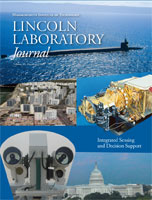Publications
Volume 16, Number 2
 |
|
Integrated Sensing and Decision Support With the advent of modern electronics, the development of advanced sensing technologies has led to an explosion in the amount of data available to decision makers in many fields. Unfortunately, the ability of humans to understand and respond to this growing flood of information has not kept pace. Lincoln Laboratory has launched a multidisciplinary research initiative in Integrated Sensing and Decision Support (ISDS) with the goal of improving decision performance across a variety of military and civil applications by augmenting advanced sensors with novel information exploitation and management techniques. Silent Hammer The Silent Hammer Limited Objective Experiment aimed to assess additional capabilities for a new class of submarines in fighting terrorism. What resulted was an excellent case study of a large-scale test of ISDS concepts, in particular the Metadata Architecture. While the independent analysis conducted by Lincoln Laboratory provided the Navy with the knowledge it needed to evaluate the capability of the submarine class, it also increased understanding of the needs of the broader community to successfully obtain and process intelligence, surveillance, and reconnaissance information to support the decision process. Air Traffic Management Decision Support During Convective Weather Flight delays caused by thunderstorms are a significant and growing problem for airlines and the flying public. Today’s coping strategies are developed by traffic-flow management specialists who interpret weather measurements and forecasts to develop delay programs and rerouting strategies that adjust traffic loads in affected airspace. The effectiveness of these strategies is limited by the lack of quantitative models for the capacity impacts of thunderstorms, and by the difficulty of developing and executing timely response strategies during rapidly changing convective weather. Service-oriented aviation weather architecture will expedite the development of integrated weather and traffic-flow management decision support tools. The simple, but highly effective Route Availability Planning Tool can significantly reduce convective weather induced departure delays at congested airports. The Traffic Alert and Collision Avoidance System Now mandated on all large transport aircraft, the Traffic Alert and Collision Avoidance System (TCAS) has had extraordinary success in reducing the risk of mid-air collisions. TCAS is the product of carefully balancing and integrating sensor characteristics, tracker and aircraft dynamics, maneuver coordination, operational constraints, and human factors in time-critical situations. Building on prior experience, Lincoln Laboratory recently examined potential improvements to the TCAS algorithms and monitored TCAS activity in the Boston area. Now the Laboratory is pursuing new collision avoidance technologies for unmanned aircraft. Decision Support in Space Situational Awareness Algorithms and systems developed by Lincoln Laboratory provide commercial and military analysts with space-object location information and decision support to address potential proximity conflicts in the space arena. Collision avoidance in the geosynchronous earth orbit belt is controlled through cooperative monitoring of satellite data. When analysts have no information about satellite maneuvers, noncooperative satellite monitoring of space surveillance data provides the only method to determine orbital status. We describe both a cooperative monitoring system and a noncooperative monitoring system that uses Bayesian networks to combine signature and metric information from space surveillance sensors. Virtual Hammer With a simulation testbed emulating the intelligence, surveillance, and reconnaissance sensors present during an exercise like the Silent Hammer experiment, and tools to measure the human decision processes taking place, we could make significant progress in the advancement of ISDS technologies. An environment such as this—Virtual Hammer—has been developed and is currently being used to explore the potential for synoptic-level sensors to cue unmanned aircraft. Enhanced Regional Situation Awareness An Integrated Air Defense System created through the coordinated response of U.S. government and local law enforcement agencies provides airspace protection in the region surrounding Washington, D.C. Selecting the appropriate response requires a means for rapidly assessing the aircraft threat. New and existing sensors must be simultaneously cued to the target of interest and integrated with existing sources of information to display a common air picture display to support the decision makers. The newly developed Enhanced Regional Situation Awareness system is an integrated sensing and decision support system for the complex and busy airspace surrounding the nation’s capital. A New Compact Facility for Antenna and Radar Target Measurements An antenna and radar-cross-section measurements facility recently built by Lincoln Laboratory provides unique test capabilities to support rapid prototyping of antennas and radar targets. One of the facility’s four anechoic chambers incorporates a large temperature-controlled rectangular chamber lined with radar-absorbing material that is arranged to reduce scattering; a composite rolled-edge offset-fed parabolic reflector; a robotic multi-feed antenna system; and a radar instrumentation system. CCD Imager Development for Astronomy Charge-coupled-device (CCD) technology at Lincoln Laboratory has played a major role in applications for space surveillance, providing imaging sensors with high quantum efficiency, low-noise readout circuits, and large pixel counts. Detector features important in space surveillance are also eagerly sought by astronomers, and for years we have made our CCD technology available to observatories. These programs have a reciprocal benefit by supporting development of novel device concepts and supplying us with comprehensive test data. We review our work in imager development for astronomy, with special emphasis on a new CCD architecture called the orthogonal transfer array. Applying Publish-Subscribe to Communications-on-the-Move Node Control Modern military satellite communications terminals have typically been built as multiprocessor systems. Because of increasing pressure for reuse and modularity, programs have been encouraged to consider the use of component middleware. The most mature middleware standard available—Common Object Request Broker Architecture—suffers from invocation semantics that present considerable challenges for the development of communications-on-the-move (COTM) systems. We found that real-time publish-subscribe middleware reduces coupling, improves composability, and lowers the risk of architectural mismatch, deadlock, and integration problems. |
|